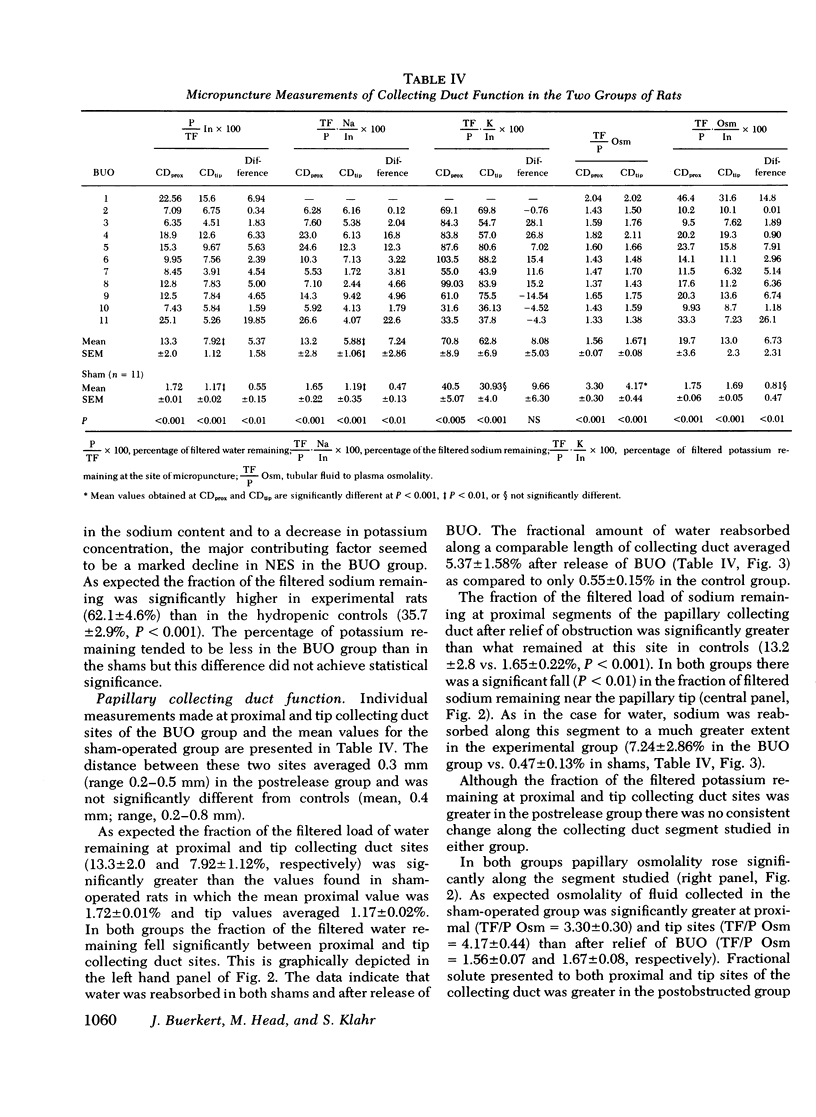Abstract
The effects of acute bilateral ureteral obstruction (BUO) of 18-h duration on deep nephron and collecting duct function were studied by micropuncture in 11 weanling rats. After release of BUO glomerular filtration rate was reduced (178±15 vs. 1,343±119 μl/min per g kidney weight in shams), while urine flow was increased averaging 17.5±1.3 vs. 6.8±0.72 μl/min per g kidney weight in controls. There was a marked increase in the absolute and fractional excretion of Na. Single nephron glomerular filtration rate of deep nephrons was reduced in the BUO group, mean 19.4±3.5 vs. 77.0±7.7 nl/min per g kidney weight in shams. Single nephron glomerular filtration rate of superficial nephrons fell to the same extent after relief of BUO. Mean tubular fluid to plasma inulin ratio of fluid from Henle's loop was 2.46±0.20 after relief of BUO vs. 8.23±0.85 in shams. This suggested a reduction in the reabsorption of Na and water before the bend of the loop of Henle, most likely in both the proximal tubule and descending limb. Fluid osmolality was depressed due to a decline in both Na and nonelectrolyte solute content. After release of BUO the percentage of filtered water remaining in the collecting duct (CD) at the base of the papilla was greater than in controls (13.3±2.0 and 1.72±0.01%, respectively) but fell significantly by the tip of the papilla to 7.92±1.12 vs. 1.17±0.02% in controls. These results indicate that water was reabsorbed along the terminal CD after relief of ureteral obstruction. In fact, a greater fraction was reabsorbed in this segment after release of BUO (5.37±1.58%) than after sham operation (0.55±0.15%). Similar changes were seen in Na excretion. Thus alterations in deep nephron function appear to contribute to the natriuresis and diuresis which follow release of BUO while terminal CD function in this model appears intact.
Full text
PDF










Selected References
These references are in PubMed. This may not be the complete list of references from this article.
- Buerkert J., Alexander E., Purkerson M. L., Klahr S. On the site of decreased fluid reabsorption after release of ureteral obstruction in the rat. J Lab Clin Med. 1976 Mar;87(3):397–410. [PubMed] [Google Scholar]
- EARLEY L. E. Extreme polyuria in obstructive uropathy; report of a case of water-losing nephritis in an infant, with a discussion of polyuria. N Engl J Med. 1956 Sep 27;255(13):600–605. doi: 10.1056/NEJM195609272551305. [DOI] [PubMed] [Google Scholar]
- Eknoyan G., Suki W. N., Martinez-Maldonado M., Anhalt M. A. Chronic hydronephrosis: observations on the mechanism of the defect in urine concentration. Proc Soc Exp Biol Med. 1970 Jul;134(3):634–639. doi: 10.3181/00379727-134-34850. [DOI] [PubMed] [Google Scholar]
- FAWCETT J. K., SCOTT J. E. A rapid and precise method for the determination of urea. J Clin Pathol. 1960 Mar;13:156–159. doi: 10.1136/jcp.13.2.156. [DOI] [PMC free article] [PubMed] [Google Scholar]
- FUHR J., KACZMARCZYK J., KRUTTGEN C. D. Eine einfache colorimetrische Methode zur Inulinbestimmung für Nieren-Clearance-Untersuchungen bei Stoffwechselgesunden und Diabetikern. Klin Wochenschr. 1955 Aug 1;33(29-30):729–730. doi: 10.1007/BF01473295. [DOI] [PubMed] [Google Scholar]
- Feldman R. A., Siegel N. J., Kashgarian M., Hayslett J., Lytton B. Intrarenal hemodynamics in postobstructive diuresis. Invest Urol. 1974 Nov;12(3):172–175. [PubMed] [Google Scholar]
- Harris R. H., Yarger W. E. Renal function after release of unilateral ureteral obstruction in rats. Am J Physiol. 1974 Oct;227(4):806–815. doi: 10.1152/ajplegacy.1974.227.4.806. [DOI] [PubMed] [Google Scholar]
- Harris R. H., Yarger W. E. The pathogenesis of post-obstructive diuresis. The role of circulating natriuretic and diuretic factors, including urea. J Clin Invest. 1975 Oct;56(4):880–887. doi: 10.1172/JCI108167. [DOI] [PMC free article] [PubMed] [Google Scholar]
- Jaenike J. R. The renal functional defect of postobstructive nephyropathy. The effects of bilateral ureteral obstruction in the rat. J Clin Invest. 1972 Dec;51(12):2999–3006. doi: 10.1172/JCI107127. [DOI] [PMC free article] [PubMed] [Google Scholar]
- Jamison R. L., Buerkert J., Lacy F. A micropuncture study of Henle's thin loop in Brattleboro rats. Am J Physiol. 1973 Jan;224(1):180–185. doi: 10.1152/ajplegacy.1973.224.1.180. [DOI] [PubMed] [Google Scholar]
- Jamison R. L., Buerkert J., Lacy F. A micropuncture study of collecting tubule function in rats with hereditary diabetes insipidus. J Clin Invest. 1971 Nov;50(11):2444–2452. doi: 10.1172/JCI106743. [DOI] [PMC free article] [PubMed] [Google Scholar]
- Jamison R. L. Micropuncture study of superficial and juxtamedullary nephrons in the rat. Am J Physiol. 1970 Jan;218(1):46–55. doi: 10.1152/ajplegacy.1970.218.1.46. [DOI] [PubMed] [Google Scholar]
- McDougal W. S., Wright F. S. Defect in proximal and distal sodium transport in post-obstructive diuresis. Kidney Int. 1972 Dec;2(6):304–317. doi: 10.1038/ki.1972.114. [DOI] [PubMed] [Google Scholar]
- Pennell J. P., Lacy F. B., Jamison R. L. An in vivo study of the concentrating process in the descending limb of Henle's loop. Kidney Int. 1974 May;5(5):337–347. doi: 10.1038/ki.1974.49. [DOI] [PubMed] [Google Scholar]
- ROUSSAK N. J., OLEESKY S. Waterlosing nephritis, a syndrome simulating diabetes insipidus. Q J Med. 1954 Apr;23(90):147–164. [PubMed] [Google Scholar]
- Schütz W., Schnermann J. Pelvic urine composition as a determinant of inner medullary solute concentration and urine osmolarity. Pflugers Arch. 1972;334(2):154–166. doi: 10.1007/BF00586788. [DOI] [PubMed] [Google Scholar]
- Sonnenberg H., Wilson D. R. The role of the medullary collecting ducts in postobstructive diuresis. J Clin Invest. 1976 Jun;57(6):1564–1574. doi: 10.1172/JCI108427. [DOI] [PMC free article] [PubMed] [Google Scholar]
- Stein J. H., Osgood R. W., Kunau R. T., Jr Direct measurement of papillary collecting duct sodium transport in the rat. Evidence for heterogeneity of nephron function during Ringer loading. J Clin Invest. 1976 Oct;58(4):767–773. doi: 10.1172/JCI108527. [DOI] [PMC free article] [PubMed] [Google Scholar]
- WINBERG J. Renal function in water-losing syndrome due to lower urinary tract obstruction before and after treatment. Acta Paediatr. 1959 Mar;48(2):149–163. doi: 10.1111/j.1651-2227.1959.tb16030.x. [DOI] [PubMed] [Google Scholar]
- Wilson D. R., Honrath U. Cross-circulation study of natriuretic factors in postobstructive diuresis. J Clin Invest. 1976 Feb;57(2):380–389. doi: 10.1172/JCI108289. [DOI] [PMC free article] [PubMed] [Google Scholar]
- Wilson D. R. Nephron functional heterogeneity in the postobstructive kidney. Kidney Int. 1975 Jan;7(1):19–26. doi: 10.1038/ki.1975.3. [DOI] [PubMed] [Google Scholar]
- Yarger W. E., Aynedjian H. S., Bank N. A micropuncture study of postobstructive diuresis in the rat. J Clin Invest. 1972 Mar;51(3):625–637. doi: 10.1172/JCI106852. [DOI] [PMC free article] [PubMed] [Google Scholar]


